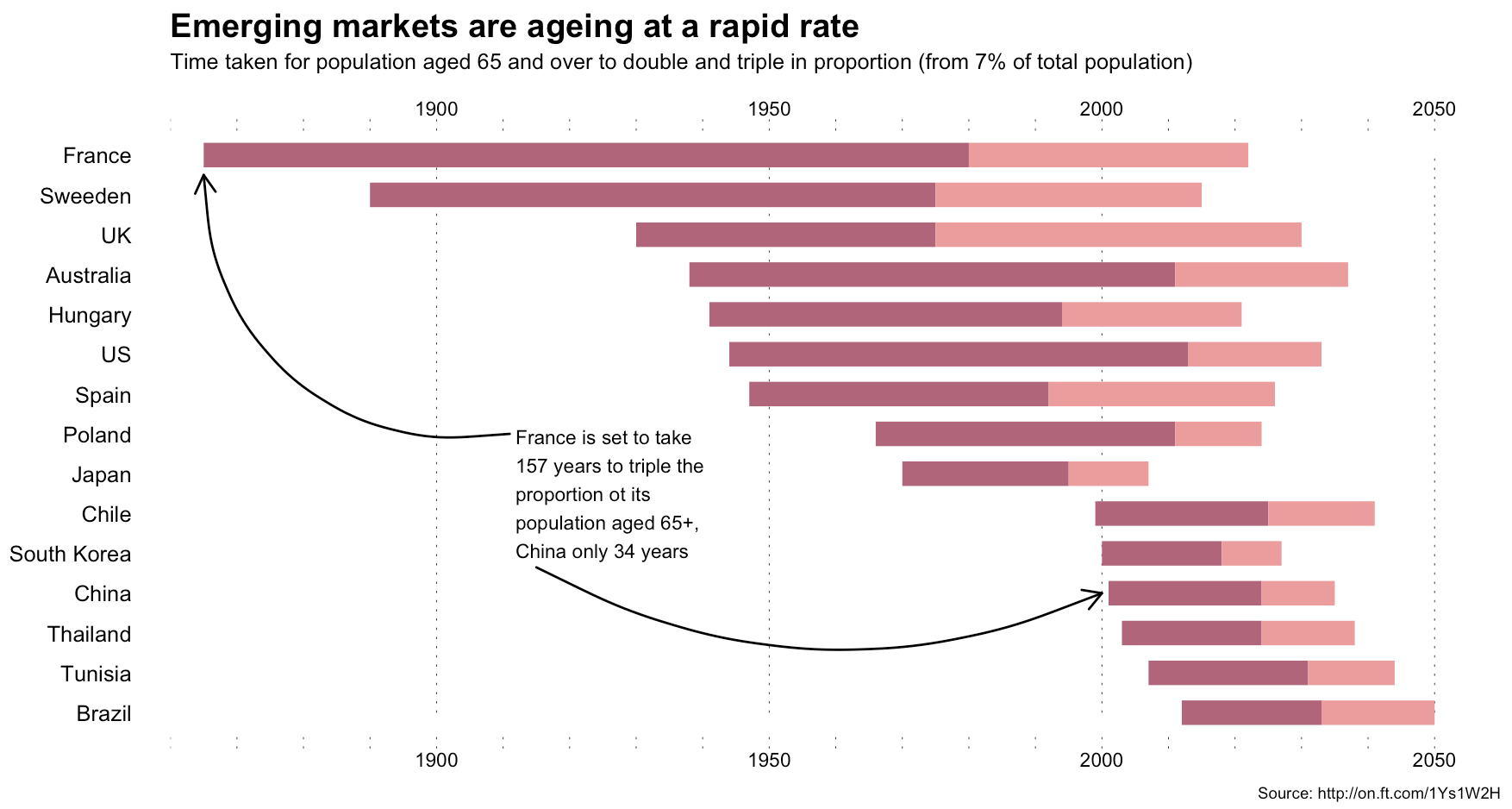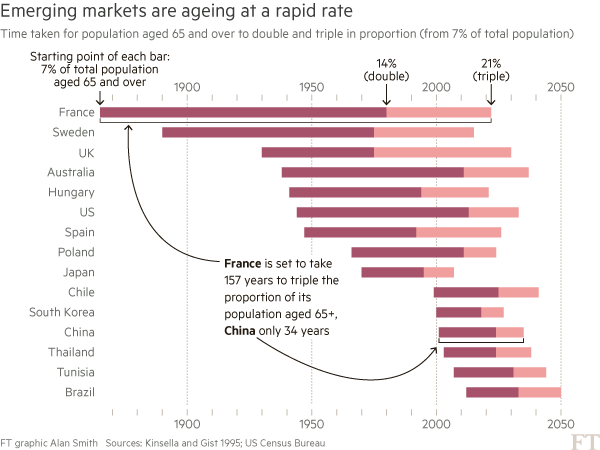Your data vis “Spidey-sense” & the need for a robust “utility belt”
@theboysmithy did a great piece on coming up with an alternate view for a timeline for an FT piece.
Here’s an excerpt (read the whole piece, though, it’s worth it):
Here is an example from a story recently featured in the FT: emerging- market populations are expected to age more rapidly than those in developed countries. The figures alone are compelling: France is expected to take 157 years (from 1865 to 2022) to triple the proportion of its population aged over 65, from 7 per cent to 21 per cent; for China, the equivalent period is likely to be just 34 years (from 2001 to 2035).
You may think that visualising this story is as simple as creating a bar chart of the durations ordered by length. In fact, we came across just such a chart from a research agency.
But, to me, this approach generates “the feeling” — and further scrutiny reveals specific problems. A reader must work hard to memorise the date information next to the country labels to work out if there is a relationship between the start date and the length of time taken for the population to age. The chart is clearly not ideal, but how do we improve it?
Alan went on to talk about the process of improving the vis, eventually turning to Joseph Priestly for inspiration. Here’s their makeover:
Alan used D3 to make this, which had me head scratching for a bit. Bostock is genius & I :heart: D3 immensely, but I never really thought of it as a “canvas” for doing general data visualization creation for something like a print publication (it’s geared towards making incredibly data-rich interactive visualizations). It’s 100% cool to do so, though. It has fine-grained control over every aspect of a visualization and you can easily turn SVGs into PDFs or use them in programs like Illustrator to make the final enhancements. However, D3 is not the only tool that can make a chart like this.
I made the following in R (of course):

The annotations in Alan’s image were (99% most likely) made with something like Illustrator. I stopped short of fully reproducing the image (life is super-crazy, still), but could have done so (the entire image is one ggplot2 object).
This isn’t an “R > D3” post, though, since I use both. It’s about (a) reinforcing Alan’s posits that we should absolutely take inspiration from historical vis pioneers (so read more!) + need a diverse visualization “utility belt” (ref: Batman) to ensure you have the necessary tools to make a given visualization; (b) trusting your “Spidey-sense” when it comes to evaluating your creations/decisions; and, (c) showing that R is a great alternative to D3 for something like this :-)
Spider-man (you expected headier references from a dude with a shield avatar?) has this ability to sense danger right before it happens and if you’re making an effort to develop and share great visualizations, you definitely have this same sense in your DNA (though I would not recommend tossing pie charts at super-villains to stop them). When you’ve made something and it just doesn’t “feel right”, look to other sources of inspiration or reach out to your colleagues or the community for ideas or guidance. You can and do make awesome things, and you do have a “Spidey-sense”. You just need to listen to it more, add depth and breadth to your “utility belt” and keep improving with each creation you release into the wild.
R code for the ggplot vis reproduction is below, and it + the CSV file referenced are in this gist.
library(ggplot2)
library(dplyr)
ft <- read.csv("ftpop.csv", stringsAsFactors=FALSE)
arrange(ft, start_year) %>%
mutate(country=factor(country, levels=c(" ", rev(country), " "))) -> ft
ft_labs <- data_frame(
x=c(1900, 1950, 2000, 2050, 1900, 1950, 2000, 2050),
y=c(rep(" ", 4), rep(" ", 4)),
hj=c(0.5, 0.5, 0.5, 0.5, 0.5, 0.5, 0.5, 0.5),
vj=c(1, 1, 1, 1, 0, 0, 0, 0)
)
ft_lines <- data_frame(x=c(1900, 1950, 2000, 2050))
ft_ticks <- data_frame(x=seq(1860, 2050, 10))
gg <- ggplot()
# tick marks & gridlines
gg <- gg + geom_segment(data=ft_lines, aes(x=x, xend=x, y=2, yend=16),
linetype="dotted", size=0.15)
gg <- gg + geom_segment(data=ft_ticks, aes(x=x, xend=x, y=16.9, yend=16.6),
linetype="dotted", size=0.15)
gg <- gg + geom_segment(data=ft_ticks, aes(x=x, xend=x, y=1.1, yend=1.4),
linetype="dotted", size=0.15)
# double & triple bars
gg <- gg + geom_segment(data=ft, size=5, color="#b0657b",
aes(x=start_year, xend=start_year+double, y=country, yend=country))
gg <- gg + geom_segment(data=ft, size=5, color="#eb9c9d",
aes(x=start_year+double, xend=start_year+double+triple, y=country, yend=country))
# tick labels
gg <- gg + geom_text(data=ft_labs, aes(x, y, label=x, hjust=hj, vjust=vj), size=3)
# annotations
gg <- gg + geom_label(data=data.frame(), hjust=0, label.size=0, size=3,
aes(x=1911, y=7.5, label="France is set to take\n157 years to triple the\nproportion ot its\npopulation aged 65+,\nChina only 34 years"))
gg <- gg + geom_curve(data=data.frame(), aes(x=1911, xend=1865, y=9, yend=15.5),
curvature=-0.5, arrow=arrow(length=unit(0.03, "npc")))
gg <- gg + geom_curve(data=data.frame(), aes(x=1915, xend=2000, y=5.65, yend=5),
curvature=0.25, arrow=arrow(length=unit(0.03, "npc")))
# pretty standard stuff here
gg <- gg + scale_x_continuous(expand=c(0,0), limits=c(1860, 2060))
gg <- gg + scale_y_discrete(drop=FALSE)
gg <- gg + labs(x=NULL, y=NULL, title="Emerging markets are ageing at a rapid rate",
subtitle="Time taken for population aged 65 and over to double and triple in proportion (from 7% of total population)",
caption="Source: http://on.ft.com/1Ys1W2H")
gg <- gg + theme_minimal()
gg <- gg + theme(axis.text.x=element_blank())
gg <- gg + theme(panel.grid=element_blank())
gg <- gg + theme(plot.margin=margin(10,10,10,10))
gg <- gg + theme(plot.title=element_text(face="bold"))
gg <- gg + theme(plot.subtitle=element_text(size=9.5, margin=margin(b=10)))
gg <- gg + theme(plot.caption=element_text(size=7, margin=margin(t=-10)))
ggYour data vis “Spidey-sense” & the need for a robust “utility belt”的更多相关文章
- Fitting Bayesian Linear Mixed Models for continuous and binary data using Stan: A quick tutorial
I want to give a quick tutorial on fitting Linear Mixed Models (hierarchical models) with a full var ...
- Machine Learning and Data Mining(机器学习与数据挖掘)
Problems[show] Classification Clustering Regression Anomaly detection Association rules Reinforcemen ...
- JavaScript资源大全中文版(Awesome最新版)
Awesome系列的JavaScript资源整理.awesome-javascript是sorrycc发起维护的 JS 资源列表,内容包括:包管理器.加载器.测试框架.运行器.QA.MVC框架和库.模 ...
- PCI Express(四) - The transaction layer
原文出处:http://www.fpga4fun.com/PCI-Express4.html 感觉没什么好翻译的,都比较简单,主要讲了TLP的帧结构 In the transaction layer, ...
- Task schedule 分类: 比赛 HDU 查找 2015-08-08 16:00 2人阅读 评论(0) 收藏
Task schedule Time Limit: 2000/1000 MS (Java/Others) Memory Limit: 32768/32768 K (Java/Others) Total ...
- Doubles 分类: POJ 2015-06-12 18:24 11人阅读 评论(0) 收藏
Doubles Time Limit: 1000MS Memory Limit: 10000K Total Submissions: 19954 Accepted: 11536 Descrip ...
- codevs 3732 解方程
神题不可言会. f(x+p)=f(x)(mod p) #include<iostream> #include<cstdio> #include<cstring> # ...
- notes: the architecture of GDB
1. gdb structure at the largest scale,GDB can be said to have two sides to it:1. The "symbol si ...
- poj 2531 Network Saboteur(经典dfs)
题目大意:有n个点,把这些点分别放到两个集合里,在两个集合的每个点之间都会有权值,求可能形成的最大权值. 思路:1.把这两个集合标记为0和1,先默认所有点都在集合0里. 2 ...
随机推荐
- 对MySQL数据量日益增长产生的一点小想法
最近一直在想一个问题 MySQL数据量日益庞大,目前单表总记录数有 300W+,导致sql语句执行的速度变慢,如果一直这样增长下去,总有一天会爆炸的.怎么办??怎么办?? 第一:想到的必然是 添加索引 ...
- jdk1.8新特性,还不知道的朋友还不看看,1.9都快出来了
一.接口的默认方法 Java 8允许我们给接口添加一个非抽象的方法实现,只需要使用 default关键字即可,这个特征又叫做扩展方法,示例如下:代码如下:interface Formula { ...
- 论.net平台的切身感触(惑)
这篇博客只是作者客观看法,不喜勿喷,条条大路通罗马,路不同风景也不一样,接下来的路该怎么走? 简介:作者.net程序员一枚,工作已有四年,接触过.net平台winform,webform,mvc的开发 ...
- 第一个 lua 程序
第一个 lua 程序 lua 提供一个交互式编程模式, 直接在命令行输入 lua 开启 $ lua > -- 此处可以输入 lua 程序 lua 脚本执行时的 2 种方式 lua + lua 脚 ...
- php curl 访问 https站点
$uri = "https://your_website"; $ch = curl_init (); $data=I('post.'); curl_setopt ( $ch, CU ...
- WPF触屏Touch事件在嵌套控件中的响应问题
前几天遇到个touch事件的坑,记录下来以增强理解. 具体是 想把一个listview嵌套到另一个listview,这时候如果list view(子listview)的内容过多超过容器高度,它是不会出 ...
- 微软的STRIDE模型
微软的STRIDE模型: https://msdn.microsoft.com/en-us/library/ee823878(v=cs.20).aspx Spoofing identity. An e ...
- 蓝桥杯-搭积木-java
/* (程序头部注释开始) * 程序的版权和版本声明部分 * Copyright (c) 2016, 广州科技贸易职业学院信息工程系学生 * All rights reserved. * 文件名称: ...
- Redis 基本安全规范文档
温馨提示:我在一家手游的公司工作,因为经常用到redis,特为此整理文档(借鉴过大神的文章): 一.什么是redis(出自百度百科)? redis是一个key-value存储系统.和Memcached ...
- Android NDK开发之从Java与C互调中详解JNI使用(一)
生活 这一个礼拜过得真的是苦不堪言,上周因为打球脚踝直接扭伤,肿的想猪蹄一样,然后休息几天消肿了,可以缓慢龟速的行走了,然而五一回来上班第一天,上班鞋子还能穿上,下班脚已插不进鞋子里面了,好吧,又肿回 ...


